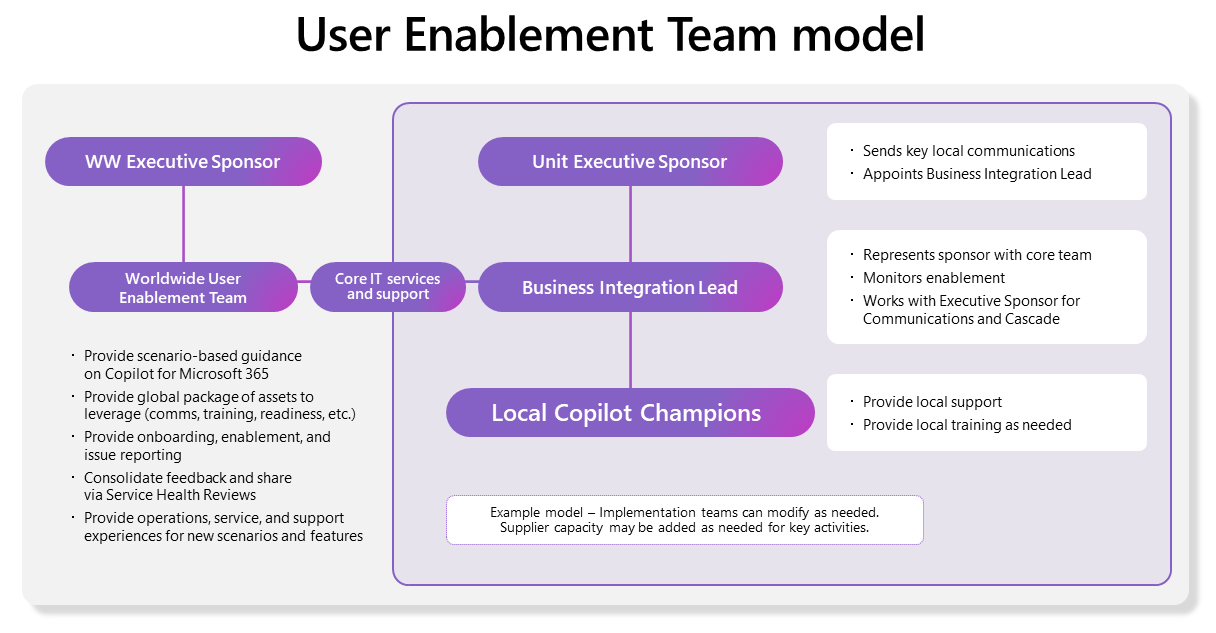Assemble your team
One of the first steps in planning your Copilot for Microsoft 365 implementation is assembling the appropriate user enablement (UE) team. Your technology UE team is central to the success of your project and your employees with your technology investments.
Transforming to this new way of working requires buy-in and support from across the business. We have identified the key groups that are critical to a successful adoption effort. These key groups bridge the technology and business outcomes that matter to your organization.
For Copilot for Microsoft 365, this team might be a specialized group within your organization already managing service roadmaps, technology strategy, governance, and implementation strategies. Each group has a specific role in the implementation and should be engaged early and often.
Depending on your organization's size and industry, this group size may vary, but it should have these key groups:
- Executive Sponsors & Business Stakeholders provide vision and overall leadership for the initiative.
- Success Owners ensure business goals are realized by helping people use and get value from the new technology.
- User Enablement (Adoption) Leaders are accountable for user satisfaction and adoption of the new capabilities.
- Business representation includes leaders and users to provide insight on target scenarios and day to day operations.
- Technical team (IT Professionals) is accountable for the technical implementation, configuration, and management of the new service. This includes help desk and internal support leaders.
- Early adopters provide valuable insights and inform the organization-wide launch.
- Champions provide user training and support before, during and after service deployment. These individuals can advocate for and promote Microsoft 365 technologies and provide peer-to-peer support and mentoring to other users.
As you recruit the UE lead and additional resources, consider the following characteristics to ensure a successful UE Team:
- Understanding of organizational change management practices
- Technical skills across Microsoft 365 collaboration tools
- Advanced program management skills
- Relevant business acumen and visibility to overall AI vision
- Strong written and verbal communications skills
- Ability to model desired leadership skills
Refer to the following table as a reference to identify key team members and additional resources, outlining their responsibilities in your adoption project.
| Role | Responsibilities | Department | Team members identified for role |
|---|---|---|---|
| Executive sponsor | Communicate high-level vision and values of Copilot for Microsoft 365 to the company.Specific examples: Send Copilot Launch announcement. Help identify and prioritize top HR needs. Connect with Security, HR, and IT leaders across the organization. Actively participate in and use the Copilot capabilities to help drive and reinforce adoption. | VP, HR | Jane Doe |
| Success Owner | Ensure the business goals are realized from your Microsoft 365 and/or Copilot rollout. | Any department | |
| Department leads (Stakeholders) | Identify how specific departments use Copilot and encourage engagement. | Any department (management) | |
| Communications Lead | Oversee company-wide communications about Microsoft 365 and/or Copilot. | Corp Communications, IT, or other | |
| Security Lead | |||
| Training Lead | |||
| Legal Leadership | |||
| IT Specialist/Technical Staff | |||
| Early Adopters | |||
| Champions | |||
| User Enablement (Adoption) Lead | |||
| Program Manager | |||
| HR Manager | |||
| Community Manager |
Tip
Though we recommend having each of these roles fulfilled throughout your implementation, you may find that you don’t require them all to get started. Visit the Adoption Team Member Role Details for more descriptions.
User Enablement Team model
The following diagram is an example of a UE Team model. Your model may appear different based on the existing structure of your organization but you can use this one as a guide as you assemble and structure your UE Team.
